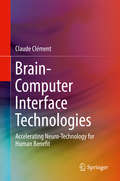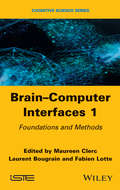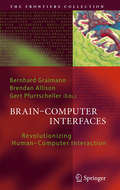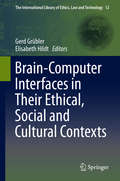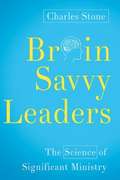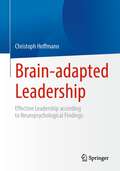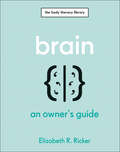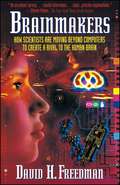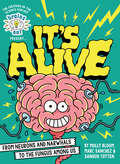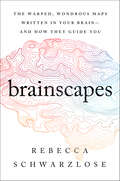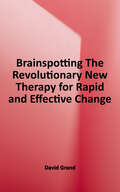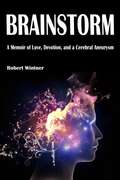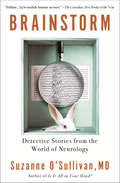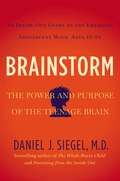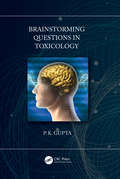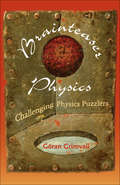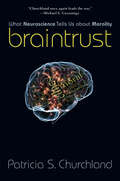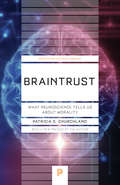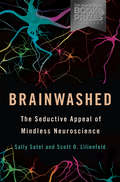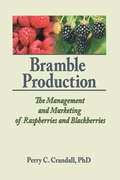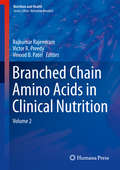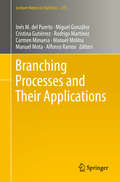- Table View
- List View
Brain-Computer Interface Technologies: Accelerating Neuro-Technology for Human Benefit
by Claude ClémentThis book is about the field of brain-computer interfaces (BCI) and the unique and special environment of active implants that electrically interface with the brain, spinal cord, peripheral nerves, and organs. At the heart of the book is the matter of repairing and rehabilitating patients suffering from severe neurologic impairments, from paralysis to movement disorders and epilepsy, that often requires an invasive solution based on an implanted device. Past achievements, current work, and future perspectives of BCI and other interactions between medical devices and the human nervous system are described in detail from a pragmatic point of view.Reviews the Active Implantable Medical Devices (AIMDs) industry and how it is moving from cardiac to neuro applicationsClear, easy to read, presentation of the field of neuro-technologies for human benefitProvides easy to understand explanations about the technical limitations, the physics of implants in the human body, and realistic long terms perspectives
Brain-Computer Interfaces 1: Methods and Perspectives
by Fabien Lotte Laurent Bougrain Maureen ClercBrain-computer interfaces (BCI) are devices which measure brain activity and translate it into messages or commands, thereby opening up many investigation and application possibilities. This book provides keys for understanding and designing these multi-disciplinary interfaces, which require many fields of expertise such as neuroscience, statistics, informatics and psychology. This first volume, Methods and Perspectives, presents all the basic knowledge underlying the working principles of BCI. It opens with the anatomical and physiological organization of the brain, followed by the brain activity involved in BCI, and following with information extraction, which involves signal processing and machine learning methods. BCI usage is then described, from the angle of human learning and human-machine interfaces. The basic notions developed in this reference book are intended to be accessible to all readers interested in BCI, whatever their background. More advanced material is also offered, for readers who want to expand their knowledge in disciplinary fields underlying BCI. This first volume will be followed by a second volume, entitled Technology and Applications
Brain-Computer Interfaces: Revolutionizing Human-Computer Interaction (The Frontiers Collection #6)
by Gert Pfurtscheller Bernhard Graimann Brendan Z. AllisonA brain-computer interface (BCI) establishes a direct output channel between the human brain and external devices. BCIs infer user intent via direct measures of brain activity and thus enable communication and control without movement. This book, authored by experts in the field, provides an accessible introduction to the neurophysiological and signal-processing background required for BCI, presents state-of-the-art non-invasive and invasive approaches, gives an overview of current hardware and software solutions, and reviews the most interesting as well as new, emerging BCI applications. The book is intended not only for students and young researchers, but also for newcomers and other readers from diverse backgrounds keen to learn about this vital scientific endeavour.
Brain-Computer-Interfaces in their ethical, social and cultural contexts (The International Library of Ethics, Law and Technology #12)
by Elisabeth Hildt Gerd GrüblerThis volume summarizes the ethical, social and cultural contexts of interfacing brains and computers. It is intended for the interdisciplinary community of BCI stakeholders. Insofar, engineers, neuroscientists, psychologists, physicians, care-givers and also users and their relatives are concerned. For about the last twenty years brain-computer-interfaces (BCIs) have been investigated with increasing intensity and have in principle shown their potential to be useful tools in diagnostics, rehabilitation and assistive technology. The central promise of BCI technology is enabling severely impaired people in mobility, grasping, communication, and entertainment. Successful applications are for instance communication devices enabling locked-in patients in staying in contact with their environment, or prostheses enabling paralysed people in reaching and grasping. In addition to this, it serves as an introduction to the whole field of BCI for any interested reader.
Brain-Savvy Leaders: The Science of Significant Ministry
by Charles StoneLeadershipdemands constant reframing and reappraisal of the situation at hand. Itrequires focus, objectivity, honest appraisal of self and others, andevaluation of available resources. An effective Christian church leadermust also align the congregation’s vision and practices with God’svision and the teachings of Christ. Perhaps most importantly, the churchleader must love others.AuthorCharles Stone uses recent neuroscience research to show how basic brainprocesses affect leadership. He writes in layperson’s language, withmemory-boosting illustrations and acronyms, helping readers to increaseproductivity, handle stress, create and sustain healthy teams, andmanage change in the church. Brain science complements and reinforcesChristian teaching on life and leadership; Brain-Savvy Leaders equips readers to use that science as a tool for improvement for life and for the church. Brain-Savvy Leaders is……the best book I have read on the brain science of healthy thinking andeffective leadership. Dr. Stone has done an incredible job of balancingmodern brain science with Biblical truth, making complex ideas simple tounderstand and providing practical tools to enhance mental performance.--Timothy R. Jennings, M.D, FAPA; President, Tennessee PsychiatricAssociation; Vice President, Southern Psychiatric Association; author, The God Shaped Brain: How Changing Your View of God Transforms Your Life…an engaging and fun read that's also insightful, informative, andpractical. A valuable resource for spiritual leaders. --Golnaz Tabinia,neuroscientist and assistant professor, Carnegie Mellon University…will help you with emotional regulation, personal productivity, teamcollaboration and change management. It's a winner! --Dan Reiland,Executive Pastor, 12Stone Church, Lawrenceville, Georgia; author, Amplified Leadership…shares helpful tips on how to master leadership in the church. I neededthis book. --Ron Edmondson, Senior Pastor, Immanuel Baptist Church,Lexington, Kentucky…can help you take your church to the next level and help you betteralign your leadership with God's desires. It will help you achievegreater focus and design more cohesive and collaborative teams. I highlyrecommend it. --Jeffrey M. Schwartz, M.D., author of You Are Not Your Brain and Brain Lock
Brain-adapted Leadership: Effective Leadership according to Neuropsychological Findings
by Christoph HoffmannThe book shows you how you can effectively integrate the latest findings of neuroscience into your everyday work or leadership. Brain-adapted leadership shows you how applied psychology from the perspective of neuroscience works both in leadership work and in everyday professional life as a whole. Based on a neuropsychological behavioral model, you will learn about the plausible connections between perceptions, needs, emotions, thinking and acting. These insights form a valuable basis for leading yourself, teams and corporate units. In addition, you will receive numerous exercise instructions and examples for illustration and practical implementation. The subject of this work is of particular importance to you if you want to better understand your own feelings and behavior and those of your fellow human beings in order to achieve valuable interactions and fulfilling work activities. Target Audience:This reference book is aimed at managers and coaches, as well as people in the world of work who are willing to work on themselves to achieve greater satisfaction, serenity and balance: and neuroscience knows that we can do this, even into old age. About the author: Christoph Hoffmann is a graduate psychologist FH, graduate engineer HTL; studied psychology with a focus on Industrial and Organizational Psychology in Zurich. He has leadership experience in various adult education institutions and works at the IAP at the ZHAW Zurich University of Applied Sciences as a consultant and lecturer in the Centre for Leadership, Coaching and Change Management.
Brain-gut Peptides and Reproductive Function
by Craig Johnston Charles D. BarnesThis book elucidates the role of brain-gut peptides in neuroendocrine regulation for understanding how these peptides interact with the reproductive neuroendocrine axis and for developing novel therapeutic agents for fertility or contraceptive therapies.
Brain: An Owner's Guide (The Body Literacy Library)
by Elizabeth R. RickerBecome body literate with Brain: An Owner's Guide, the next book in The Body Literacy Library, an enlightening series that democratizes health for a new generation of readers.Brain: An Owner’s Guide is an informative and practical guide to all aspects of brain health, from maximizing your mental well-being today to protecting your brain against future serious health issues. Leading neuroscientist Eli Ricker explains how the brain works, discusses how you can take care of and protect your brain, and explains what you can do to improve your memory and concentration at any age. Ricker also looks at what constitutes mental "well-being" and the science behind a positive mindset, resilience, concentration, and memory, as well as low mood, depression, and brain fog. Dementia and other brain disorders are a huge concern for many, and Ricker looks at how these occur, the latest medical research, and what you can do to protect your brain for life.Author Elizabeth Ricker is an engaging and media-friendly neuroscientist who specializes in brain health research, with a particular emphasis on brain "hacking," memory, and concentration. She translates medical jargon into simple, clear prose, answering frequently asked patient queries, such as "How can I improve my concentration?," "Do brain games work?," "Is dementia hereditary?," "What is good brain food?," "Why do I have brain fog?," and much more.From the importance of sleep and stress management to why dementia is a feminist issue, this hardworking book applies science to the everyday, with simple illustrations, checklists, FAQs, and myth busters, all supported by the latest medical research. Brain: An Owner’s Guide can help you better understand your mind and aims to enhance your long-term quality of life.
Brainmakers
by David FreedmanHOW SCIENTISTS ARE MOVING BEYOND COMPUTERS TO CREATE A RIVAL TO THE HUMAN BRAIN
Brains
by Leif ØstergaardA short but engaging exploration of the brain.In Brains, scientist Leif Østergaard explores our most complicated and mysterious organ. From the dissection of Einstein's brain to research on how to map networks of neurons, Østergaard deconstructs the different parts of the brain and provides an engaging overview of its essential functions. He explains how we store information in the synapses of neural networks and how these networks carry commands to our muscles and internal organs and receive sensory input from our skin, eyes, ears, nose, and mouth. Delving into the subconscious, we learn what our brains are doing while we daydream and how neurotransmitters play a role in addiction. In this fascinating book, Østergaard reveals how this enigmatic organ is even more complex than we thought it was.In Reflections, a series copublished with Denmark's Aarhus University Press, scholars deliver 60-page reflections on key concepts. These books present unique insights on a wide range of topics that entertain and enlighten readers with exciting discoveries and new perspectives.
Brains On! Presents...It's Alive: From Neurons and Narwhals to the Fungus Among Us
by Molly Bloom Marc Sanchez Sanden TottenThe creators of the award-winning science podcast for kids, Brains On!, present a humorous, highly illustrated, fact- and fun-filled look at life on Earth— from deep sea creatures and carnivorous plants to the human body and stinky bacteria. Perfect for STEM collections! Did you ever wonder why jellyfish sting? Or if trees communicate with each other? How about why you can't tickle yourself?Well hold on to your noggins, because you're about to find out! Join the creators of the award-winning science podcast Brains On! as they explore the uber-awesome and sometimes gross world of biology—aka the study of living things. Inside these pages, you'll meet animals with superpowers, plants that eat meat, brains that trick you, and tiny microbes that live, well . . . all over you!Packed with mind-boggling facts and laugh-out-loud jokes, this book promises a brain-bending, jaw-dropping, belly-laughing good time as readers watch the world around them come ALIVE.
Brainscapes: The Warped, Wondrous Maps Written in Your Brain—And How They Guide You
by Rebecca SchwarzloseAn exploration of how perception, thought, and action are products of maps etched into your brain—and how technology can use them to read your mind.Your brain is a collection of maps. That is no metaphor: scrawled across your brain’s surfaces are actual maps of the sights, sounds, and actions that hold the key to your survival. Scientists first began uncovering these maps over a century ago, but we are only now beginning to unlock their secrets—and comprehend their profound impact on our lives. Brain maps distort our experience of the world, shape how we think and imagine, and open the door to mind-reading technologies. Their idiosyncrasies shine a light on our past and offer clues to our possible futures. In Brainscapes, Rebecca Schwarzlose combines unforgettable real-life stories, cutting-edge research, and vivid illustrations to reveal brain maps’ surprising lessons about our place in the world—and about the world’s place within us.Praise for Brainscapes“A profoundly illuminating account of how the brain works. . . . Rebecca Schwarzlose is a neuroscientist with a novelist’s literary flair.” —Cass R. Sunstein, author of Too Much Information“Deeply enjoyable and thoroughly researched. . . . Schwarzlose’s presentation of cutting-edge science is consistently accessible and precise.” —Publishers Weekly (starred review)“Brainscapes will change how you think about the brain and how you understand your own mind.” —Tali Sharot, author of The Influential Mind
Brainspotting: The Revolutionary New Therapy for Rapid and Effective Change
by David GrandBrain-based therapy is the fastest-growing area in the field of psychological health because it has proven that it can immediately address issues that talk therapy can take years to heal. Now Dr. David Grand presents the next leap forward in psychological care―combining the strengths of brain-based and talk therapies into a powerful technique he calls Brainspotting. In Brainspotting, Dr. Grand reveals the key insight that allowed him to develop this revolutionary therapeutic tool: that where we look reveals critical information about what's going on in our brain. Join him to learn about: <p>• The history of Brainspotting―how it evolved from EMDR practice as a more versatile tool for brain-based therapy <p>• Brainspotting in action―case studies and evidence for the effectiveness of the technique <p>• An overview of the different aspects of Brainspotting and how to use them <p>• Between sessions―how clients can use Brainspotting on their own to reinforce and accelerate healing <p>• Why working simultaneously with the right and left brain can lead to expanded creativity and athletic performance <p>• How Brainspotting can be used to treat PTSD, anxiety, depression, addiction, physical pain, chronic illness, and much more <p><p> "Brainspotting lets the therapist and client participate together in the healing process," explains Dr. Grand. "It allows us to harness the brain's natural ability for self-scanning, so we can activate, locate, and process the sources of trauma and distress in the body." With Brainspotting, this pioneering researcher introduces an invaluable tool that can support virtually any form of therapeutic practice―and greatly accelerate our ability to heal.
Brainstorm
by Robert WintnerNine million Americans are touched by aneurysms during their lifetime. This is one story of love.Brainstorm is the candid and powerful memoir of the author's harrowing experience of an aneurysm and his road to recovery. It is a journey of love, devotion, and a clash of medical beliefs and countercultures. The fierce resolve of the author and his wife is extraordinary, inspiring, and matched only by the tremendous competence and care of the medical system-one to which the author initially stands in opposition, but that he later learns to admire and respect.This book is for anyone who has experienced the fear and difficulties of a major illness. The themes, truths, and above all, the compassion that this book shares will be familiar not just to the nine million Americans affected by aneurysms, but to anyone whose family has been touched by a medical trauma. Filled with raw emotion, Brainstorm affords quiet but powerful support to those suffering similar circumstances and strives to tell them that they are not alone.
Brainstorm: Detective Stories from the World of Neurology
by Suzanne O'SullivanA leading neurologist recounts some of her most astonishing, challenging cases, which demonstrate how crucial the study of epilepsy has been to our understanding of the brain.Brainstorm follows the stories of people whose medical diagnoses are so strange even their doctor struggles to know how to solve them. A man who sees cartoon characters running across the room; a girl whose world suddenly seems completely distorted, as though she were Alice in Wonderland; another who transforms into a ragdoll whenever she even thinks about moving.The brain is the most complex structure in the universe. Neurologists must puzzle out life-changing diagnoses from the tiniest of clues, the ultimate medical detective work. In this riveting book, Suzanne O'Sullivan takes you with her as she tracks the clues of her patients' symptoms. It's a journey that will open your eyes to the unfathomable intricacies of our brains and the infinite variety of human experience.
Brainstorm: The Power and Purpose of the Teenage Brain
by Daniel J. SiegelIn this New York Times-bestselling book, Dr. Daniel Siegel shows parents how to turn one of the most challenging developmental periods in their children's lives into one of the most rewarding. Between the ages of 12 and 24, the brain changes in important, and oftentimes maddening, ways. It's no wonder that many parents approach their child's adolescence with fear and trepidation. According to renowned neuropsychiatrist Daniel Siegel's New York Times bestseller Brainstorm, if parents and teens can work together to form a deeper understanding of the brain science behind all the tumult, they will be able to turn conflict into connection and form a deeper understanding of one another. In Brainstorm, Siegel illuminates how brain development impacts teenagers' behavior and relationships. Drawing on important new research in the field of interpersonal neurobiology, he explores exciting ways in which understanding how the teenage brain functions can help parents make what is in fact an incredibly positive period of growth, change, and experimentation in their children's lives less lonely and distressing on both sides of the generational divide. Brainstorm is a current nominee for a Books for a Better Life award.
Brainstorming Questions in Toxicology
by P. K. GuptaBrainstorming Questions in Toxicology is designed to serve as a comprehensive, quick reference supplement for various examinations that include sections on toxicology. It reflects the breadth and multidisciplinary nature of toxicology with an objective approach to the subject. With 3500 short questions and answers, multiple choice questions, true/false or correct/incorrect statements, fill in the blanks, and matching the statements, this book is a helpful tool for students, teachers and toxicologists preparing for licensure and certification exams. It is also a resource or refresher for toxicologists working in pharmacy, medical, clinical and forensic toxicology, veterinary, and other related fields such as environment and eco-toxicology. Key Features: Serves as a refresher for academicians and professionals in the field of toxicology Provides an essential guide for the student who needs a study aid for toxicology and the teacher of toxicology who needs inspiration when composing questions for their students Supplements in-house training courses in toxicology that exist in some pharmaceutical and chemical industries
Brainstorms: Philosophical Essays on Mind and Psychology
by Daniel Clement DennettDiscussions on artificial intelligence, philosophy, and cognitive psychology.
Brainteaser Physics: Challenging Physics Puzzlers
by Göran GrimvallDoes a glass of ice water filled to the brim overflow when the ice melts? Does the energy inside a sauna increase when you heat it up? What's the best way to cool your coffee—adding the creamer first or last? These and other challenging puzzlers provide a fresh—and fun—approach to learning real physics. Presenting both classic and new problems, Brainteaser Physics challenges readers to use imagination and basic physics principles to find the answers. Göran Grimvall provides detailed and accessible explanations of the solutions, sometimes correcting the standard explanations, sometimes putting a new twist on them. He provides diagrams and equations where appropriate and ends each problem by discussing a specific concept or offering an extra challenge.With Brainteaser Physics, students and veteran physicists alike can sharpen their critical and creative thinking—and have fun at the same time.
Braintrust: What Neuroscience Tells Us About Morality
by Patricia S. ChurchlandWhat is morality? Where does it come from? And why do most of us heed its call most of the time? In Braintrust, neurophilosophy pioneer Patricia Churchland argues that morality originates in the biology of the brain. She describes the "neurobiological platform of bonding" that, modified by evolutionary pressures and cultural values, has led to human styles of moral behavior. The result is a provocative genealogy of morals that asks us to reevaluate the priority given to religion, absolute rules, and pure reason in accounting for the basis of morality. Moral values, Churchland argues, are rooted in a behavior common to all mammals--the caring for offspring. The evolved structure, processes, and chemistry of the brain incline humans to strive not only for self-preservation but for the well-being of allied selves--first offspring, then mates, kin, and so on, in wider and wider "caring" circles. Separation and exclusion cause pain, and the company of loved ones causes pleasure; responding to feelings of social pain and pleasure, brains adjust their circuitry to local customs. In this way, caring is apportioned, conscience molded, and moral intuitions instilled. A key part of the story is oxytocin, an ancient body-and-brain molecule that, by decreasing the stress response, allows humans to develop the trust in one another necessary for the development of close-knit ties, social institutions, and morality. A major new account of what really makes us moral, Braintrust challenges us to reconsider the origins of some of our most cherished values.
Braintrust: What Neuroscience Tells Us about Morality (Princeton Science Library)
by Patricia S. ChurchlandWhat is morality? Where does it come from? And why do most of us heed its call most of the time? In Braintrust, neurophilosophy pioneer Patricia Churchland argues that morality originates in the biology of the brain. She describes the "neurobiological platform of bonding" that, modified by evolutionary pressures and cultural values, has led to human styles of moral behavior. The result is a provocative genealogy of morals that asks us to reevaluate the priority given to religion, absolute rules, and pure reason in accounting for the basis of morality. Moral values, Churchland argues, are rooted in a behavior common to all mammals--the caring for offspring. The evolved structure, processes, and chemistry of the brain incline humans to strive not only for self-preservation but for the well-being of allied selves--first offspring, then mates, kin, and so on, in wider and wider "caring" circles. Separation and exclusion cause pain, and the company of loved ones causes pleasure; responding to feelings of social pain and pleasure, brains adjust their circuitry to local customs. In this way, caring is apportioned, conscience molded, and moral intuitions instilled. A key part of the story is oxytocin, an ancient body-and-brain molecule that, by decreasing the stress response, allows humans to develop the trust in one another necessary for the development of close-knit ties, social institutions, and morality. A major new account of what really makes us moral, Braintrust challenges us to reconsider the origins of some of our most cherished values.
Brainwashed: The Seductive Appeal of Mindless Neuroscience
by Scott O. Lilienfeld Sally SatelIn recent years, the advent of MRI technology seems to have unlocked the secrets of the human mind, revealing the sources of our deepest desires, intentions, and fears. As renowned psychiatrist and scholar Sally Satel and psychologist Scott O. Lilienfeld demonstrate in Brainwashed, however, the explanatory power of brain scans in particular and neuroscience more generally has been vastly overestimated. Although acknowledging its tremendous potential, the authors argue that the overzealous application of the burgeoning field of brain science has put innocent people in jail, prevented addicts from healing themselves, and undermined notions of free will and responsibility. A provocative challenge to the use and abuse of a seductive science, Brainwashed offers an essential corrective to determinist explanations of human behavior.
Bramble Production
by Perry C. CrandallBramble Production provides growers with a basic understanding of how raspberry and blackberry plants grow and respond to changes in their environment. Author Perry Crandall includes management practices used by successful growers, making this book a helpful production guide that you can use for making rational decisions. This knowledge of successful production can be used to recommend or adopt management programs specially designed to produce optimum yields with maximum profits.
Branched Chain Amino Acids in Clinical Nutrition: Volume 2 (Nutrition and Health)
by Victor R. Preedy Vinood B. Patel Rajkumar RajendramThis is the first volume in a 2-volume compendium that is the go-to source for both research- and practice-oriented information on the importance of branched chain amino acids in maintaining the nutritional status and overall health of individuals, especially those with certain disease conditions. Over 150 well recognized and respected contributors have come together to compile these up-to-date and well-referenced works. The volumes will serve the reader as the benchmarks in this complex area of interrelationships between dietary protein intakes and individual amino acid supplementation, the unique role of the branched chain amino acids in the synthesis of brain neurotransmitters, collagen formation, insulin and glucose modulation and the functioning of all organ systems that are involved in the maintenance of the body's metabolic integrity. Moreover, the physiological, genetic and pathological interactions between plasma levels of branched chain amino acids and aromatic amino acids are clearly delineated so that students as well as practitioners can better understand the complexities of these interactions. Branched Chain Amino Acids in Clinical Nutrition: Volume 1 covers basic processes at the cellular level, inherited defects in branched chain amino acid metabolism, and experimental models of growth and disease states.
Branching Processes and Their Applications (Lecture Notes in Statistics #219)
by Inés M. del Puerto Miguel González Cristina Gutiérrez Rodrigo Martínez Carmen Minuesa Manuel Molina Manuel Mota Alfonso RamosThis volume gathers papers originally presented at the 3rd Workshop on Branching Processes and their Applications (WBPA15), which was held from 7 to 10 April 2015 in Badajoz, Spain (http://branching. unex. es/wbpa15/index. htm). The papers address a broad range of theoretical and practical aspects of branching process theory. Further, they amply demonstrate that the theoretical research in this area remains vital and topical, as well as the relevance of branching concepts in the development of theoretical approaches to solving new problems in applied fields such as Epidemiology, Biology, Genetics, and, of course, Population Dynamics. The topics covered can broadly be classified into the following areas: 1. Coalescent Branching Processes 2. Branching Random Walks 3. Population Growth Models in Varying and Random Environments 4. Size/Density/Resource-Dependent Branching Models 5. Age-Dependent Branching Models 6. Special Branching Models 7. Applications in Epidemiology 8. Applications in Biology and Genetics Offering a valuable reference guide to contemporary branching process theory, the book also explores many open problems, paving the way for future research.
